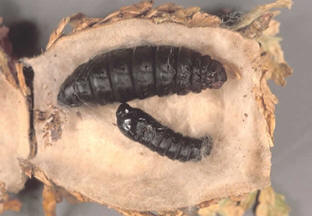Bagworm
 DESCRIPTION
DESCRIPTION
The Bagworm is a perennial insect pest of Arborvitae, Juniper, Pine, Spruce and many other evergreen species. It may also attack certain deciduous trees such as Black Locust, Honeylocust and Sycamore. The insect is most easily recognized by the case or bag that the caterpillar forms and suspends from ornamental plants on which it feeds. The bag is made of silk and bits of host leaves and twigs. These materials are interwoven to disguise and add strength to the case. When the caterpillar is mature, the bag may be 30-50 mm in total length. Young larvae hatching from the eggs are approximately 2 mm long, glossy black on the back and dull amber on the undersurface of their bodies. Full grown larvae are dull, dirty gray and splotched with darker markings toward the head. Mature larvae are about 18-25 mm long. The adult female bagworm is worm-like. It lacks eyes, wings, functional legs and mouth parts. She never leaves the bag that she constructed as a larva. The adult male is sooty black and moth-like with transparent wings that are nearly devoid of scales.
LIFE CYCLE
Bagworms overwinter as eggs inside the female bag. Female bagworms lay 500-1000 eggs in each bag during the previous fall. Eggs will start hatching from late May through early June. Upon hatching, the young larvae crawl out of the bag and start to feed and construct silken shelters over their bodies. As the larvae grow over the eight to ten week feeding period, they continue to enlarge the exterior of their bags with pieces of foliage, bits of bark, or other plant parts. Feeding and development usually continue until August. Mature larvae loop strands of silk around a twig and become firmly attached. After the top of the bag is closed, larvae reverse their position in the bags so that their heads face downward. They then change into the pupal (resting) stage and remain in this life stage for about 4 weeks. During September and early October, the males leave their cases and fly to bags containing females where mating takes place. Each mated female deposits a mass of eggs inside her bag. She crawls out of the bag after laying eggs, drops to the ground and dies. The eggs overwinter inside the bag until the following Spring. There is only one generation a year in Pennsylvania.
 DAMAGE
DAMAGE
Bagworm larvae injure plants when they feed on needles and leaves. Young caterpillars feed on the upper epidermis of host plants, sometimes leaving small holes in the foliage. Damage by mature larvae is especially destructive to evergreen plants. Trees such as Sycamore, Willow and other deciduous trees, usually refoliate after heavy defoliation. Unfortunately, Bagworm infestations generally go undetected until damage is complete, and the large bags of these insects are very conspicuous. Early detection of an infestation requires careful examination of host plants for the presence of small Bagworms attached to the leaves or needles.
CONTROL
Non-Chemical
Bagworms may be controlled on small shrubs and trees by handpicking or cutting the bags from infested plants during late Fall, Winter or early Spring, before egg hatch. Dispose of the bags so that this pest will not reenter your landscape. A number of natural enemies attack the larval and egg stages of the Bagworm. Apparently, natural enemies are responsible for Bagworm population changes from year to year.
Chemical
When Bagworms are too numerous to handpick, an insecticide application may be indicated. Formulations of many insecticides are labeled for Bagworm control.* Treat after eggs hatch and caterpillars are small during early to mid June. Follow all label directions for specific information on host plant label clearance, phytotoxicity information, safety precautions and dosage information.
* See Woody Ornamental Insect, Mite and Disease Management, The Pennsylvania State University (2005) for more details.
WARNING: Pesticides are poisonous. Read and follow directions and safety precautions on labels. Handle carefully and store in original labeled containers out of reach of children, pets and livestock. Dispose of empty containers right away , in a safe manner and place. Do not contaminate forage, streams or ponds.
For professional assistance with tree and shrub problems contact a Keystone arborist
Penn State Fact Sheet on Bagworm


